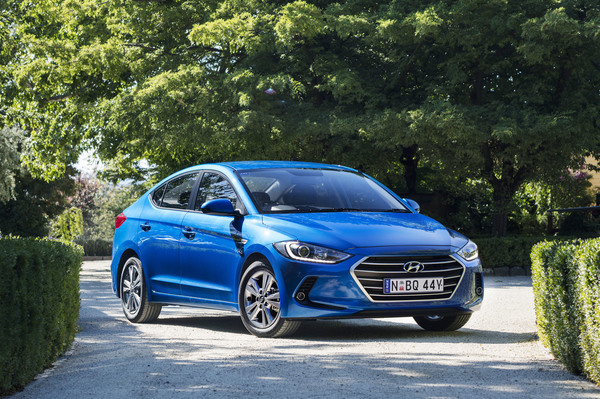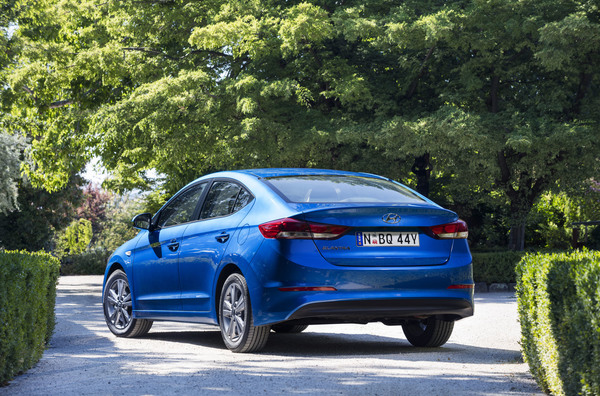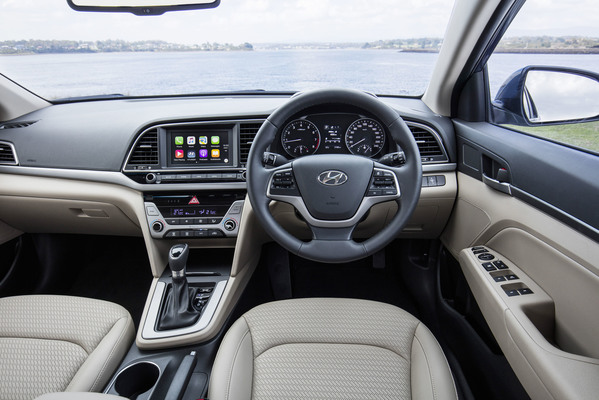By ALISTAIR KENNEDY
ALTHOUGH it doesn’t attract as much attention as its i30 hatch twin, the Hyundai Elantra sedan has been in the Korean carmaker’s Australian range since 1991.
The latest sixth generation Elantra, which has just been launched, gets extra thrust from a new 2.0-litre petrol engine (up from a 1.8) as well as a facelift, equipment upgrade and extra size.
The most significant improvement, however, is beneath the surface with a more rigid chassis and suspension changes providing increased occupant safety and comfort through improved noise, vibration and harshness (NVH) suppression as well as better vehicle dynamics.
Local Hyundai engineers played an important part in the development and testing of the new chassis and suspension which uses significantly more advanced high-strength steel and new aerospace-derived advanced structural adhesives.
The new Elantra gets the latest Hyundai hexagonal grille flanked by slimline headlights atop vertical LED daytime running lights.
In profile it has retained the attractive coupe-like lines from preceding models.
As is the norm with model upgrades, the new Elantra is larger than before with 20 mm added to the length, 25 mm to the width and a minimal 5 mm extra height.
Two variants are offered – the entry-level Active with a six-speed manual gearbox at $21,490 or the six-speed automatic ($23,790), and $26,490 for the auto-only Elite.
The only engine option is a 2.0-litre naturally-aspirated petrol which replaces the previous 1.8-litre used in the outgoing gen 5 Elantra.
Outputs, while increased, don’t match the extra engine capacity with power up just 2 kW to 112 kW and torque going from 178 Nm to 192 Nm.
The new torque peak does come in 700 rpm lower on the tachometer at 4000 rpm.
Standard safety features include six airbags; ABS brakes with electronic brakeforce distribution and brake assist; electronic stability and traction control; reversing camera; rear parking sensors; and hill start assist.
The Elite’s $2700 price surcharge over the Active offers excellent value with a variety of extras features including chrome radiator grille surrounds and belt-line moulding; smartkey and push-button start/stop; leather-trim interior (the Active is cloth only); powered folding side mirrors; auto dimming interior rear-vision mirror; rain-sensing wipers; 17-inch alloy wheels (16-inch alloys in the Active); dual-zone climate control air conditioning; and rear seat cooling vents in the centre console; boot cargo net; and illuminated front door handles and sunvisors.
The Elite also gets a clever automatic boot opening feature.
Unlike the kick motion under the rear of the car used by other brands the Elantra uses sensors to recognise when the owner is within a metre of the rear of the car and, provided that the car is locked, flashes the taillights three times and, unless cancelled via the smartkey, then opens the boot lid.
Another interesting innovation in the Elite is an adjustable turn signal operation which allows the driver to pre-set the number of turn signal indicator to three, five or seven flashes.
Front and rear shoulder room is improved by 7 mm and 12 mm respectively although a good haircut will give you more extra headroom than the additional 4 mm in the rear.
The biggest change by far, however, is in the rear legroom which is increased by 59 mm adding to its appeal to the growing-family segment of the market.
The changes to the vehicle’s suspension, specifically new vertical dampers, have meant a small reduction in boot space but it’s still a very useable 458 litres.
The spare wheel beneath the boot floor is a matching full-size one.
After our recent experience with a number of French cars and their annoying interior layouts it was refreshing to step into a car where everything is in the right place.
The dashboard is clean and uncluttered with controls that are arranged in a logical and functional manner.
There are twin different-sized drink holders and storage areas in the centre console and a space for smartphones and the USB socket at the base of the dashboard.
Infotainment display is through a seven-inch LCD touchscreen with large, clear tabs that keep the driver’s eyes off the road for the minimum amount of time.
For the same reason the screen is tilted slightly towards the driver.
To keep the Elantra’s price down Hyundai has opted out of installing built-in satellite navigation in either variant but rather, in line with a growing trend, mapping and guidance is only available through the multimedia system when connected via a smartphone app.
At this stage it only links through an iPhone and the Apple CarPlay system. Android users will need to bide their time for a software upgrade later this year.
We were able to test new Elantra at its launch out of Launceston and came away most impressed.
Through what passes for suburbia in the Apple Isle it felt more comfortable and refined than before but the big change came when we headed to the north-west along a series of excellent driving roads.
The extra torque was noticeable while the chassis and suspension changes have combined to provide a much more rigid body and moved it up several notches in its driving dynamics with a composed and stable ride, and more responsive steering.
Obviously it’s nowhere near being a sporty car but, more importantly, the changes do make new Elantra much safer because they will protect the careless or inattentive driver in the event of potentially dangerous situations whether they be an inexperienced junior driver or a daydreaming senior one.
For those looking for a little more excitement a 150 kW SR version will be added to the range in the second half of this year.
Although a far bigger seller internationally, the Elantra has been something of a quiet achiever in Australia, attracting steady sales and a solid platform of return buyers.
Interestingly Hyundai Australia did briefly consider renaming Elantra as the i30 sedan, a marketing ploy which, together with the big advances in the sedan, would have seen it making a serious challenge for top spot in the Australian vehicle sales chart.
Hyundai describes the new models as the “Best-Ever Elantra” and it’s hard to find fault with that claim.
It remains well-priced (especially with its five year, unlimited kilometre warranty) and attractive but now gets a larger engine, extra equipment and significantly better driving dynamics so is well worth checking out.
The Hyundai range is available for test drive at Berwick Hyundai, 34 Kangan Drive, Berwick. Phone 9707 1212.










